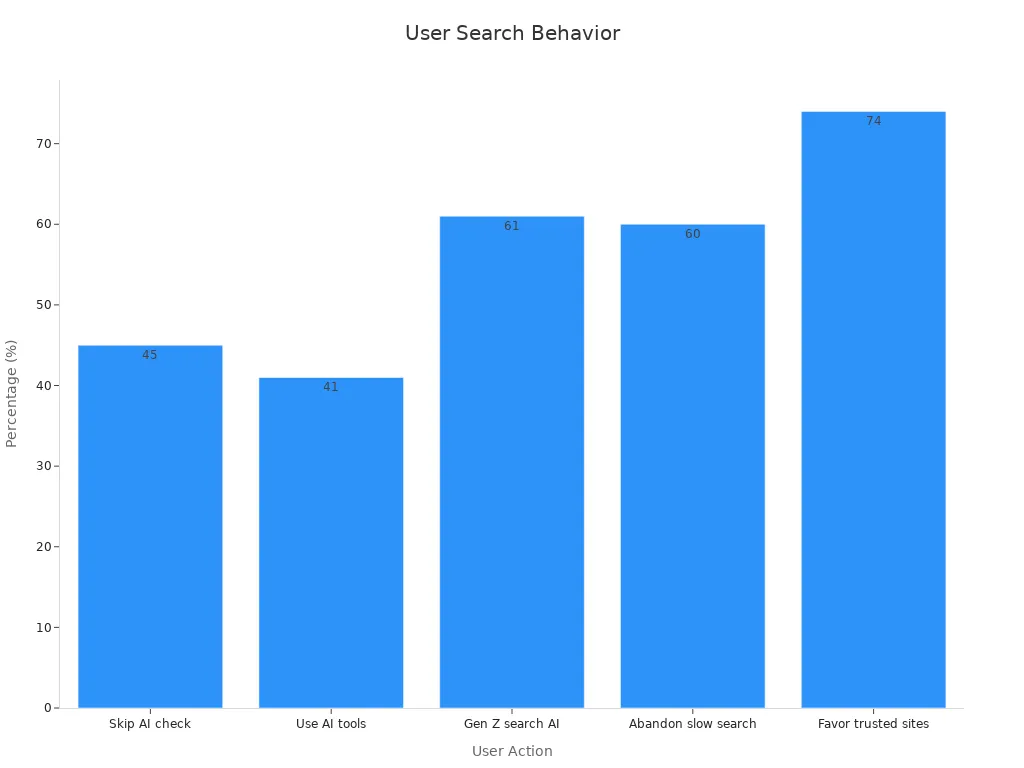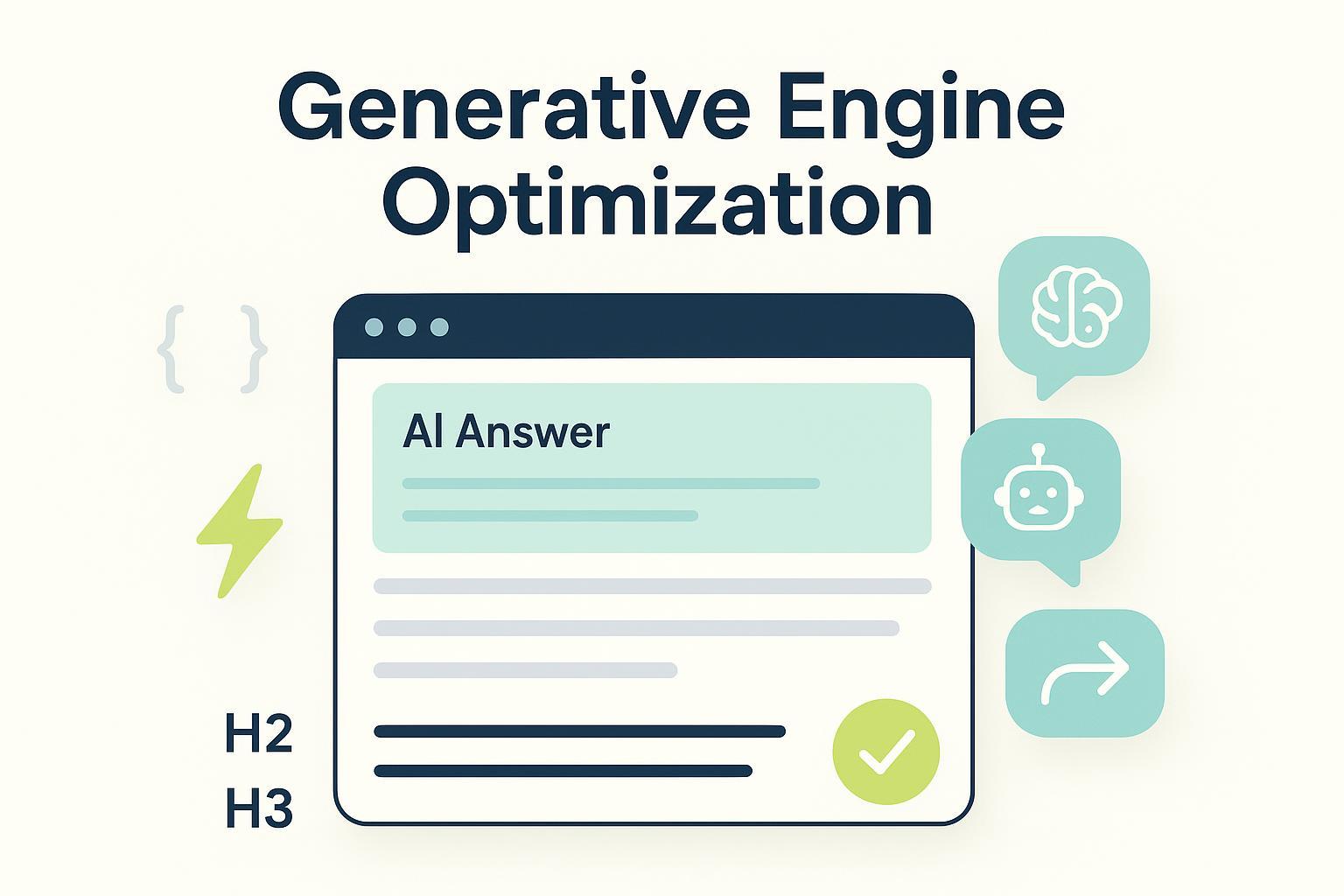How OpenAI’s Search Product Could Reshape GEO
OpenAI’s Search Product is transforming GEO by prioritizing AI-friendly content. Learn how businesses can adapt to stay visible in AI-driven search.


OpenAI’s Search Product is changing how we use search engines. Its chat-like features make searching easier and more natural. Old SEO tricks don’t work as well anymore. For instance, AI Overviews caused a 34.5% drop in clicks on the first result. Organic clicks also fell from 1.41% to 0.64% when AI Overviews showed up. These tools also help people work faster. Users finish tasks 158% quicker with ChatGPT than with Google. As search changes, businesses must adjust to stay noticed and meet new user needs.
Key Takeaways
Generative Engine Optimization (GEO) helps AI tools find content easily. It is different from SEO, which focuses on search engine rankings.
To do well in AI searches, make content clear and simple. Organize it well and answer user questions directly.
Businesses need to adjust as users now want quick answers from AI instead of visiting websites.
Using structured data and formats like FAQs can help content show up in AI answers. This keeps brands important.
Businesses must keep learning and trying new things to stay ahead in the fast-changing world of AI search.
The Role of GEO in AI-Driven Search

Defining Generative Engine Optimization (GEO)
Generative Engine Optimization (GEO) is a way to make content easy for AI tools to find. Unlike SEO, which helps websites rank high on Google, GEO makes sure AI models like ChatGPT and Bard use your content. Your content should be simple, clear, and well-organized. Using lists, Q&A formats, or special coding like schema markup helps AI understand it better.
Aspect | SEO | GEO |
|---|---|---|
Rank on search engines like Google. | Be cited by AI models like ChatGPT. | |
Optimization Focus | Keywords and backlinks. | Context clarity and structured data. |
Performance Tracking | Impressions and clicks. | Mentions in AI responses and AI citations. |
How GEO Differs from Traditional SEO Practices
GEO focuses on helping AI models, not just search engines. SEO uses keywords, links, and website health to rank higher. But GEO cares more about clear facts and easy-to-read language. AI tools like short, accurate, and well-organized content. They prefer tables, summaries, and other simple formats. This is because people now ask AI for answers instead of clicking links. This change reduces the need for regular website visits.
Why GEO Is Critical in the Era of AI-Powered Search Engines
AI-powered search engines are changing how people look for information. By 2025, over 60% of users may depend on AI tools for searching. These tools give direct answers, leading to fewer clicks on websites. For businesses, old SEO methods might not work anymore. GEO helps your content appear in AI answers, keeping your brand visible. Without GEO, your business could be ignored as AI tools take over search habits.
How OpenAI’s Search Product Impacts GEO
Key features of OpenAI’s Search Product
OpenAI’s Search Product brings new tools that make searching better. These tools help the model follow instructions, use features well, and plan prompts. For example:
The model follows directions 20% more accurately than before.
Tools work 2% better, making interactions smoother.
Prompt planning improved by 4%, helping with tricky questions.
These updates show why clear prompts are important. When you give clear instructions, the model gives better answers. OpenAI’s Search Product also works with newer models, so you need to adjust your prompts. This keeps your content useful as AI tools improve.
Improvement Type | Performance Increase |
|---|---|
Adherence to Instructions | 20% |
Tool Usage Improvement | 2% |
Planning Prompts Improvement | 4% |
The shift to conversational and context-aware search
OpenAI’s Search Product changes search into a chat-like experience. It guesses what you want and gives helpful ideas. This makes research easier by breaking big tasks into smaller ones. It also lets you focus on thinking and being creative.
Some key features include:
Agentic Retrieval: Makes answers 40% more accurate than older systems.
Multi-part Requirement Detection: Handles hard questions well.
Dynamic Query Decomposition: Creates smaller questions and ranks answers smartly.
These tools make search feel more like talking to a person. For example, fixing spelling mistakes and rewriting questions automatically improves searches. OpenAI’s Search Product makes finding answers simple and personal.
Feature | Description |
|---|---|
Agentic Retrieval | Makes answers 40% more accurate. |
Multi-part Requirement Detection | Handles hard questions well. |
Dynamic Query Decomposition | Creates smaller questions and ranks answers smartly. |
Changing user behavior and expectations in search
AI tools like OpenAI’s Search Product are changing how people search. Studies show 45% of users skip results they think are AI-made. Also, 41% use tools like ChatGPT for detailed answers. Gen Z leads this change, with 61% using AI tools often.
People now want fast and correct answers. Three out of five leave top results if their questions aren’t answered quickly. Also, 74% prefer content from trusted experts or websites. This shows why making good, reliable content is important.

As OpenAI’s Search Product grows, you need to change your strategies. Focus on making chat-like, clear, and trustworthy content. This helps your brand stay visible and important in the new search world.
Implications for Businesses and Marketers
The need for AI-friendly, high-quality content
AI tools like OpenAI’s Search Product prefer clear and simple content. Businesses should create material that works well with AI and users. Good content keeps your brand visible in AI search results. For example:
CarMax used GPT-3 to turn 100,000 reviews into new web content. This improved their SEO traffic.
Coca-Cola asked users to make 120,000 images, boosting site activity.
Starbucks uses AI to send custom offers, increasing loyalty and repeat sales.
These examples show how AI-friendly content helps businesses grow. To succeed, use formats like FAQs, lists, and summaries. These make it easier for AI tools to understand and rank your content.
Challenges in adapting to generative search environments
Generative search creates new problems for marketers. Click-through rates (CTRs) are dropping, and costs per click (CPC) are rising. Zero-click searches, where answers appear directly on AI platforms, lower website visits. By April 2025, Google AI Overviews showed up in 40.2% of local business searches, changing visibility.
Marketers need to focus on visibility instead of clicks. This means changing strategies to make sure AI includes your content in answers. Adjusting to these changes is hard but necessary to stay competitive.
Opportunities for businesses to leverage GEO for growth
Generative Engine Optimization (GEO) gives businesses ways to grow. Using location data helps you study customer habits and find trends. For example:
Learn where customers go and how they move around.
Pick the best store locations based on foot traffic.
Compare visit shares to understand competitors.
Track customer journeys to improve services.

The chart shows how AI search affects visibility in industries. For example, window cleaning services have a 65% GAIO appearance rate. Personal injury attorneys see 62.1%. These numbers show why optimizing content for AI tools is key to staying visible and attracting customers.
Strategies to Adapt to OpenAI’s Search Product
Optimizing content for conversational and generative search
To succeed with AI-driven search, make your content easy for AI to use. Generative models like OpenAI’s Search Product prefer clear and direct answers. Your content should be simple, well-organized, and answer questions directly.
Here are ways to improve your content for AI search:
Use natural language: Write like you’re talking to someone. Avoid hard-to-understand words unless needed.
Focus on intent: Think about what users want to know. Create content that solves their problems.
Incorporate structured data: Add schema markup to help AI understand your content better. This increases the chance of being featured in AI answers.
Leverage FAQs and summaries: Turn tough topics into easy questions and answers. Start articles with summaries to highlight key points.
Making your content simple and conversational helps it show up more in AI search results.
Using AI tools to enhance GEO strategies
AI tools can make your Generative Engine Optimization (GEO) work better. They help you analyze data, save time, and improve your plans. For example, ChatGPT can give you ideas for content, and analytics tools can track how well your content performs.
Metric | Description |
|---|---|
Measures how jobs change with AI tools. | |
Baseline vs. AI-integrated | Compares tasks before and after using AI. |
Time Savings | Tracks how much faster tasks are with AI. |
Productivity Gains | Shows how much more work gets done with AI. |
Redundancy Risk | Checks if jobs might disappear because of AI. |
Comparative Impact Dashboard | Displays data on how AI affects GEO efforts. |
AI tools also help track important metrics like:
Organic Traffic: See how many people visit from search engines. This shows how visible your content is.
Engagement Rate: Look at how long visitors stay and how many pages they view. This shows if your content is helpful.
Conversion Rates: Track how many visitors take actions like signing up or buying something.
Using AI tools in your GEO strategy saves time, boosts efficiency, and improves results.
Staying proactive with continuous learning and experimentation
The digital world changes fast, so you need to keep learning and trying new things. Testing and improving your strategies helps you stay ahead. This approach lets you adjust to changes in user habits and AI updates.
Here’s why learning and experimenting are important:
Testing ideas helps you find what works best and improve over time.
Regional innovation hubs let you work with experts and learn from others. These hubs focus on local needs to create better solutions.
Flexible plans help you adjust to different situations while keeping your audience’s trust.
By staying curious and open to change, you can keep your GEO strategies effective and up-to-date.
The Future of GEO in a Generative Search Ecosystem

Predictions for AI’s Role in Reshaping Search
AI is changing how search engines work. It’s not just about keywords anymore. Searches are now based on what users mean and want. AI tools understand your needs and context better than before. This makes search results more personal and useful.
The guide *Orange 142 Unveils Essential Guide for Brand Visibility in the Generative AI Search Era* explains why GEO is important. Businesses must adjust to AI-driven search to stay visible. AI tools quickly study big data, find trends, and improve marketing plans.
Aspect | Description |
|---|---|
SEO Practices | |
Data Analysis | AI studies big data fast, giving better marketing ideas. |
Market Trends | AI finds new trends to help businesses perform better. |
As AI improves, search engines will give even better results. This will change how you search and what you expect from it.
How Businesses Can Future-Proof Their GEO Strategies
To prepare for the future, businesses need flexible GEO plans. Create special pages for each location you serve. Make sure your site works well on phones since most searches are mobile. Partner with local bloggers or news sites for backlinks. Ask happy customers for reviews to build trust. Share local stories to connect with your audience.
Ensure your site works smoothly on mobile devices.
Work with local partners to get backlinks.
Use reviews to build trust and improve rankings.
Mixing GEO with traditional SEO keeps your content useful for both AI and search engines.
The Importance of Adaptability in a Rapidly Evolving Landscape
Being flexible is crucial in today’s fast-changing world. By 2025, 75% of marketing will involve AI, and 70% of strategies will depend on it. To succeed, follow trends, know your audience, and use multiple channels.
Statistic/Trend | Percentage/Impact |
|---|---|
Keeping up with new trends | 38% |
Understanding and defining target audiences | 36% |
Coordination across marketing channels | 35% |
Accessing and leveraging customer data | 33% |
AI-driven marketing activities by end of 2025 | 75% |
Digital marketing strategies powered by AI in 2025 | 70% |

To succeed, embrace change and try new ideas. Stay ahead by being flexible and open to learning. This will keep your GEO strategies strong in a fast-moving world.
OpenAI’s Search Product has changed how people use search engines. AI connects users to content, moving focus from SEO to GEO. To stay noticed, focus on intent, context, and clear content. People now use AI more than visiting websites directly. This makes GEO important for keeping your brand relevant. Adapting to these changes helps you succeed in a fast-changing digital world.
FAQ
What is Generative Engine Optimization (GEO)?
GEO helps make content easy for AI tools like ChatGPT. It ensures your writing is clear, organized, and simple for AI to use. Unlike SEO, GEO focuses on getting your content into AI answers instead of just ranking high on search engines.
How does GEO differ from SEO?
SEO uses keywords and links to improve search rankings. GEO focuses on clear writing, structured data, and context for AI models. It shifts from getting clicks to being mentioned in AI-generated answers, matching how people now search.
Why is GEO important for businesses?
AI tools are changing how people search for information. GEO makes sure your content shows up in AI answers, keeping your brand visible. Without GEO, your business might lose attention as AI tools become more popular.
How can you optimize content for GEO?
Write in a natural way and use clear formats like FAQs. Add structured data and focus on what users need. These steps help AI tools understand and rank your content better.
What tools can help with GEO strategies?
AI tools like ChatGPT can help create content, and analytics tools track traffic and engagement. These tools save time, boost results, and make your GEO strategy stronger.
See Also
Top 5 Sectors Benefiting from Generative Search Technology
Understanding AI Search: Its Functionality and Importance
Strategies for Excelling in AI Search Optimization by 2025





